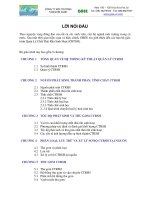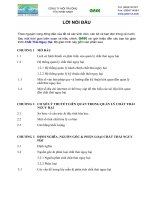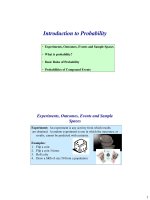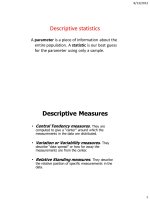Tài liệu thống kê - LAMNGHIEPVN.INFO (Hưng Bùi) ď
Bạn đang xem bản rút gọn của tài liệu. Xem và tải ngay bản đầy đủ của tài liệu tại đây (393.92 KB, 19 trang )
Introduction to Probability
• Experiments, Outcomes, Events and Sample Spaces
• What is probability?
• Basic Rules of Probability
• Probabilities of Compound Events
Experiments, Outcomes, Events and Sample
Spaces
Experiment: An experiment is any activity from which results
are obtained. A random experiment is one in which the outcomes, or
results, cannot be predicted with certainty.
Examples:
1. Flip a coin
2. Flip a coin 3 times
3. Roll a die
4. Draw a SRS of size 50 from a population
1
Basic Outcomes and Sample Spaces
Basic Outcome (o): A possible outcome of the experiment
Sample Space: The set of all possible outcomes of an
experiment
Example: A company has offices in six cities, San Diego, Los
Angeles, San Francisco, Denver, Paris, and London. A new
employee will be randomly assigned to work in one of these
offices.
A example of Outcomes:
Sample Space:
Example #2: A random sample of size two is to be selected from
the list of six cities, San Diego, Los Angeles, San Francisco,
Denver, Paris, and London.
Outcomes:
Sample Space:
2
Assigning Probabilities to Events
Probability of an event P(E): “Chance” that an event will occur
• Must lie between 0 and 1
• “0” implies that the event will not occur
• “1” implies that the event will occur
Types of Probability:
• Objective
Relative Frequency Approach
Equally-likely Approach
Probability : a
number between O
and I that reflects
the likelihood of
some event
• Subjective
Relative Frequency Approach: Relative frequency of an event
occurring in an infinitely large number of trials
Time Period
Number of Male
Live Births
Total Number of Live
Births
Relative Frequency of
Live Male Birth
1965
1927.054
3760.358
0.51247
1965-1969
9219.202
17989.360
0.51248
1965-1974
17857.860
34832.050
0.51268
This method used for an experiment where it is not
possible to apply the classical approach (usually because
outcomes not equally likely or the experiment is not
repeatable under uniform conditions).
The probability of an event E is the relative frequency of
occurrence of E or the proportion of times E occurs in a
large number of trials of the experiment.
3
Example of relative frequency method
Party supported Per cent
support
Conservative
Liberal
38
27
NDP
17
Green
9
Bloc Québécois
8
If I meet an individual Canadian and
I know nothing about this person, the
best estimate of the probabilities that
the person supports the various
parties are:
P (individual is a Conservative
supporter) = 0.38
P (individual supports the Green
Party) = 0.09
Source:
m/national/politics/, 12:15
p.m., Sept. 17, 2008
Equally-likely Approach: If an experiment must result in n equally
likely outcomes, then each possible outcome must have
probability 1/n of occurring.
Examples:
1. Roll a fair die
2. Select a SRS of size 2 from a population
4
Examples of classical method
Equally-likely Approach
• P (2 heads in two tosses of a coin) = 1/4 = 0.250
• P (obtain 4 in roll of one die) = 1/6 = 0.167
• P (total of 4 when rolling two dice) = 3/36 = 1/12 =
0.083
If one randomly selects individuals from a large
population that is ½ male and ½ female:
• P (one male and one female if 2 individuals selected)
= 2/4 = 1/2 = 0.500
• P (two females and one male if 3 individuals selected)
= 3/8 = 0.375
Subjective Probability: A number between 0 and 1 that reflects a
person’s degree of belief that an event will occur
Example: Predictions for rain
P (UR Rams will defeat the SFU Clan this Saturday) = 0.7
P (S & P TSX index will increase in trading on Monday) = 0.3
P (I will have an auto accident during the next 6 months) = 0.02
P (some snow will fall in Regina before the end of October) = 0.97
5
Probability Rule
•
•
•
•
•
•
Complement of an event
Addition law – intersection and union
Mutually exclusive
Conditional probability
Independence
Multiplication law
Probabilities of Compound Events
(Sự kiện phức hợp)
• Law of Complements (Biến cố đối lập):
“If A is an event, then the complement of A, denoted by A ,
represents the event composed of all basic outcomes in S
that do not belong to A.”
A
S
• Additive Law of Probability:
6
Law of Complements
“If A is an event, then the complement of A, denoted by ,
represents the event composed of all basic outcomes in S that
do not belong to A.”
A
A
S
Law of Complements:
P( A) 1 P( A)
Example: If the probability of getting a “working” computer is ).7,
What is the probability of getting a defective computer?
Combining events (ASW, 157160)
What is the probability that more than one
event has occurred? If there are two
events:
Both events could occur – this is referred to as
the intersection of the two events.
At least one of the events could occur – this is
referred to as the union of the two events.
Neither event occurs.
7
Intersection of two events
• The intersection of events A and B is the event
containing only the sample points belonging to
both A and B (ASW, 158).
• The notation for the intersection is P(AB).
• Read this as “probability of A intersection B”
or the “probability of A and B.”
• The probability of A and B is the sum of the
probabilities of all the sample points common
to both A and B.
Intersection of two events
• The intersection of events A and B is the event
containing only the sample points belonging to
both A and B (ASW, 158).
• The notation for the intersection is P(AB).
• Read this as “probability of A intersection B”
or the “probability of A and B.”
• The probability of A and B is the sum of the
probabilities of all the sample points common
to both A and B.
8
Unions and Intersections of Two Events
• Unions of Two Events
“If A and B are events, then the union of A and B, denoted
by AB, represents the event composed of all basic
outcomes in A or B.”
• Intersections of Two Events
“If A and B are events, then the intersection of A and B,
denoted by AB, represents the event composed of all
basic outcomes in A and B.”
A
B
S
Additive Law of Probability
Let A and B be two events in a sample space S. The probability
of the union of A and B is
P( A B) P( A) P( B) P( A B).
A
B
S
The probability that at least
one event occurs is the
probability of one event
plus the probability of the
other. But to avoid double
counting, the probability of
the intersection of the two
events is subtracted
9
Using Additive Law of Probability
Example: At State U, all first-year students must take
chemistry and math. Suppose 15% fail chemistry, 12% fail
math, and 5% fail both. Suppose a first-year student is selected
at random. What is the probability that student selected failed
at least one of the courses?
A
B
S
• Simple event
• Compound event: A compound event consists of
two or more simple events (Biến cố phức hợp)
• Independent event: whether or not one event
occurs ( more on this later) (Biến cố độc lập)
• Mutually exclusive event: two event that cannot
occur at the same time (Biến cố xung khắc)
• Impossible event has probability O (Biến cố rỗng)
• Certain event has probability I (Biến cố chắc
chắn)
10
Mutually Exclusive Events
Biến cố xung khắc
Mutually Exclusive Events: Events that have no basic
outcomes in common, or equivalently, their intersection is the
empty set.
Let A and B be two events in a sample space S. The probability
of the union of two mutually exclusive events A and B is
P( A B) P( A) P( B).
A
B
S
Example of mutually exclusive
events
If 3 persons are randomly selected from a large
population of half females and half males,
what is the probability of selecting 3 females
(A) and at least 2 males (B)?
Event A has sample point (F, F, F) .
Event B has sample points (F, M, F), (M, F,
M), (M, M, F) and (M, M, M) .
Events A and B have no sample points in
common, so P(AB) = 0.
11
Multiplication Rule and
Independent Events
Multiplication Rule for Independent Events: Let A and B
be two independent events, then
P( A B) P( A) P( B).
Examples:
• Flip a coin twice. What is the probability of observing two heads?
• Flip a coin twice. What is the probability of getting a head and then a tail? A
tail and then a head? One head?
• Three computers are ordered. If the probability of getting a “working” computer
is .7, what is the probability that all three are “working” ?
Conditional probabilities (ASW, 162167)
• A conditional probability refers to the
probability of an event A occurring, given that
another event B has occurred.
• Notation: P(A B)
• Read this as the “conditional probability of A
given B” or the “probability of A given B.“
• These are especially useful because
probabilities of an event differ, depending on
other events occurring.
12
Formulae for conditional
probabilities
• The probability of A given B is
P( A B)
P( A B)
P( B)
• The probability of B given A is
P( B A)
P( A B)
P( A)
Number of students by major and
Excel skill level
Major of
student
Excel skill level
None (N)
Low (L)
Total
Medium (M)
High (H)
Math (MA)
0
2
4
0
6
Business (B)
1
3
6
3
13
Economics (E)
2
12
8
2
24
Other (O)
0
1
1
1
3
Total
3
18
19
6
46
This table contains the same data as examined earlier,
but reorganized as a table rather than in a tree diagram.
13
Examples of conditional probabilities
from student survey
• Probability that each major has low skill level?
P(L MA) = P(L MA) / P(MA) = (2/46) / (6/46) = 2/6 =
0.333
P(L B) = 3 / 13 = 0.231
P(L E) = 0.500
P(L O) = 0.333
If a student has a high skill level is Excel, what is the
probability his or her major is Business? Other?
P(B H) = P(B H) / P(H) = (3/46) / (6/46) = 3/6 = 0.500
P(O H) = 0.167
Number of Saskatchewan residents with various levels
of wages and salaries and schooling, 2000
Wages and
salaries
Years of schooling
<12
12-13
14-17
Total
18+
<$20,000
38
84
47
8
177
$20-45,000
69
135
101
20
325
$45,000+
21
72
82
23
198
128
291
230
51
700
Total
14
Some conditional probabilities
What is the conditional probability of $45,000 in wages and
salaries given less than twelve years of schooling? Given 1417 years of schooling? Given 18+ years?
P(45+ <12) = P(45+ <12) / P(<12) = 21/ 128 = 0.164
P(45+ 14-17) = 82/ 230 = 0.357
P(45+ 18+) = 0.451
That is, chances of a high income increase with each higher level
of schooling.
What is the probability that someone with a middle level of
income has 12-13 years of schooling?
P(12-13 20-45) = P(12-1320-45) / P(<20-45) = 135/ 325 =
0.415
Conditional probabilities of various levels of wages and
salaries, given years of schooling, n=700 Saskatchewan
residents, 2000
Wages and
salaries
<$20,000
Years of schooling
<12
12-13
14-17
Total
18+
0.297 0.289 0.204 0.157 0.253
$20-45,000 0.539 0.464 0.439 0.392 0.464
$45,000+
0.164 0.247 0.357 0.451 0.283
1.000 1.000 1.000 1.000 1.000
15
Independent and dependent events
(ASW, 166)
Two events A and B are independent if
P(A B) = P(A) or P(B A) = P(B).
That is, the probability of one event is not altered by whether
or not the other event occurs.
If P(A B) = P(A), then P(B A) = P(B), and vice-versa.
Two events A and B are dependent if
P(A B) ≠ P(A) or P(B A) ≠ P(B).
In this case, the occurrence of one event affects the
probability of the other event.
Example of dependence
Does the event of having low wages and salaries depend
on having few years of schooling?
If A is the event of having a low salary (<$20,000) and B is the
event of having less than twelve years of schooling
P(A B) = 38/128 = 0.297
P(A) = 177/700 = 0.253
And P(A B) > P(A) so the chance of having low wages and
salaries is greater for those with the least amount of schooling,
as compared with the whole sample.
Also note in this case that P(B A) = 38/177 = 0.215 > 0.183 =
P(B). This is an alternative way of checking for whether the
events are dependent or independent.
16
Example of independence
Are the events of having 12-13 years of schooling (A) and the
event of having wages and salaries of $20-45,000 (B)
dependent or independent?
P(A B) = 135/325 = 0.415
P(A) = 291/700 = 0.416
So these two events are essentially independent of each other.
Also note that
P(B A) = 135/291 = 0.464
P(B) = 325/700 = 0.464
In this case, those with a middle level of schooling (12-13 years)
and the middle category of income are similar to a crosssection of the whole sample.
Using dependence and independence
Some authors have argued that parents in higher socio-economic
positions may have a greater tendency to expect their children
to be independent earlier than those with less education and
income….However, the analysis…does not show support for
these interpretations. Parents with a higher level of education
were neither more not less likely than less well-educated
parents to live with their adult children. Nor were parents
with high personal income any less likely than those with
lower personal income to provide accommodation for their
children.
Source: “Parents with adult children living at home.” Statistics Canada, Canadian Social
Trends, Spring 2006.
17
Independence and dependence in
economic analysis
Is the price of wheat received by
Saskatchewan farmers dependent on the
weather in Russia?
Is the chance of NAFTA being renegotiated
dependent on the result of the U.S.
presidential election?
Is the consumption of table salt dependent on
interest rates? Is it dependent on health
fads?
More on Multiplication rule
(ASW, 165)
The multiplication rule can be used to compute the
probability of the intersection of two events.
P(A ∩ B) = P(A) P(B A)
P(A ∩ B) = P(B) P(A B)
But note that if events A and B are independent of
each other, then P(B A) = P(B) and P(A B) =
P(A), so that
P(A ∩ B) = P(A) P(B)
18
Example of multiplication rule
What is the probability of wages and salaries of $20-45,000
(A) and having 12-13 years of schooling (B)?
Since we already know that A and B are independent,
P(A) x P(B) = (325/700) x (291/700) = 0.193.
Note that P(A ∩ B) = 135 / 700 = 0.193 from the table.
What is the probability of wages and salaries of $45,000+ (C)
and having 14-17 years of schooling (D)?
In this case, we have not checked for independence, so use
the full formula:
P(C ∩ D) = P(C) P(D C) = (198/700)X(82/198) = 82/700
= 0.117
19









